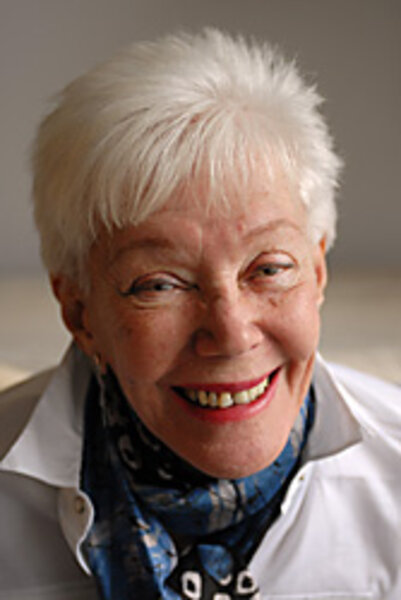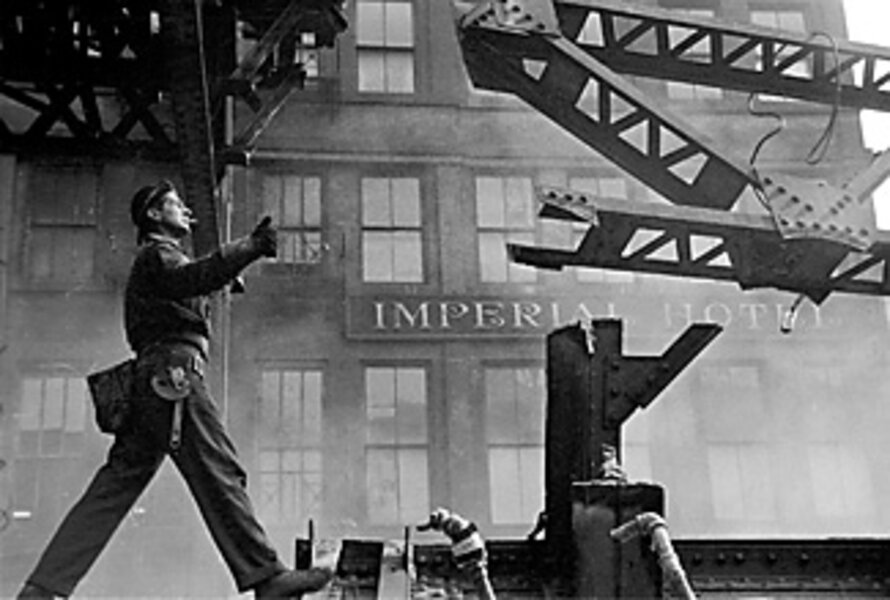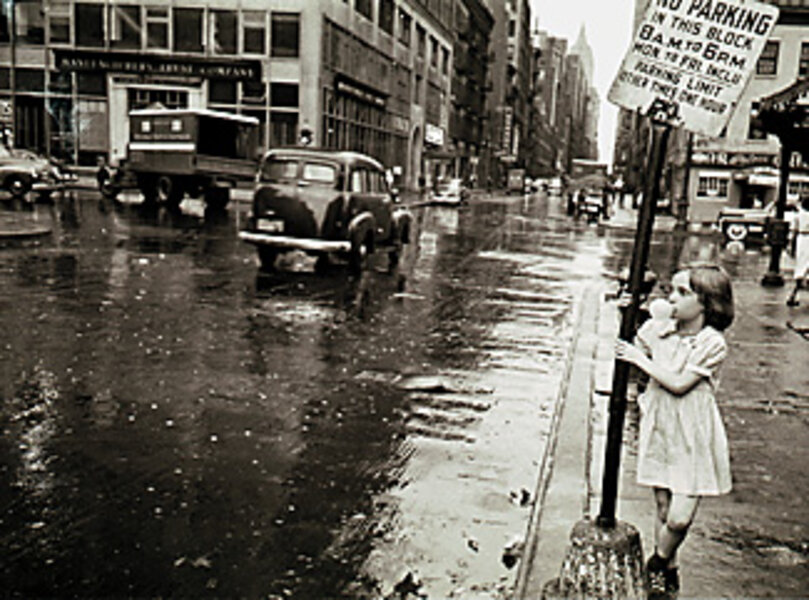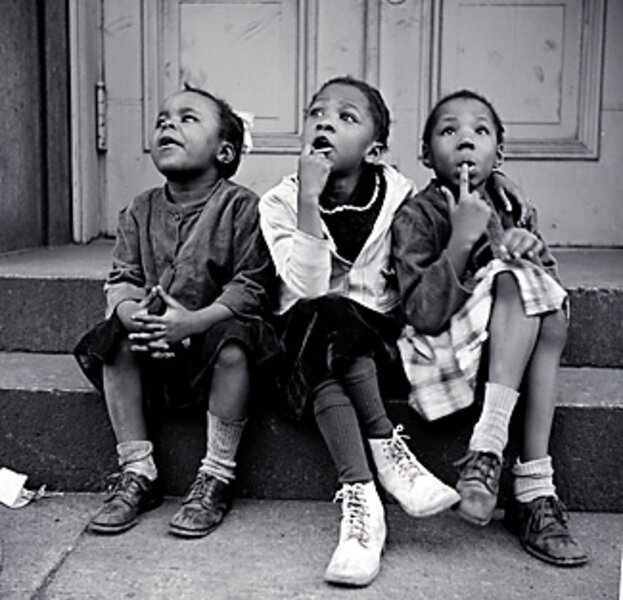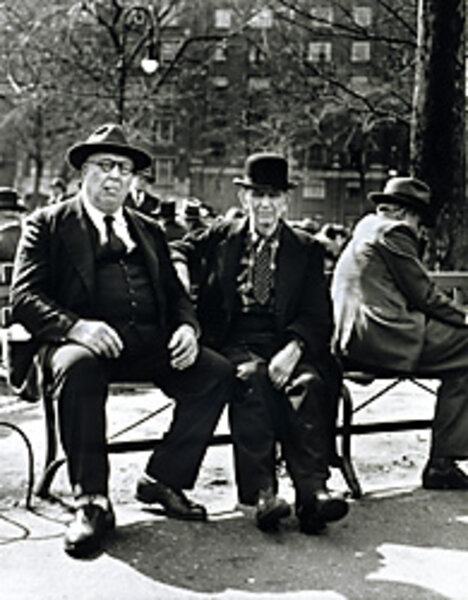A New York street photographer keeps on clicking
Loading...
| New York
Twice a week, Vivian Cherry – a veteran street photographer – leaves her midtown Manhattan apartment and gets on a bus.
"I never have any idea what I'm going to shoot," she says of her routine. But she does have a destination in mind – maybe East Harlem, where she was born, or the Lower East Side.
When she arrives – sometimes finding herself on a block she hasn't seen in 50 years – she wanders past bodegas, through parks and street fairs, like a patient hunter.
"I try to be invisible," Ms. Cherry says. Thin and white-haired, clad in jeans and sneakers, she pretty much blends into the street. "Once somebody sees you, everything changes. You don't get what you're looking at."
When somebody catches her eye, Cherry doesn't hesitate. She explains wryly that if that person calls out, "'Don't take my picture!' I just say, 'I didn't.' And I walk away."
For 60 years, on and off, Cherry has been photographing the enormous changes and small mood shifts of New York City streets. As a young woman, working for prominent magazines of the '40s and '50s such as Parade and Pageant, she caught a world that was on the verge of vanishing: She shot cattle being herded across the cobblestones of the Meatpacking District and hushed crowds watching the tearing down of the Third Avenue El. Now approaching 90, she is still fascinated by the city's changes: In a rapidly gentrifying Manhattan, she recently shot a weary Mexican father on a stoop, his sleeping daughter draped across his lap.
She's one of the last surviving members of the Photo League, a cooperative of photographers that in the '30s and '40s embraced social realism.
At an age when it might be easier to slow down, Cherry is not only passionately engaged, she's experiencing a sense of arrival. Her first book, "Helluva Town" – 82 black-and-white photos of New York City in the '40s and '50s, with her commentary – has just been published by powerHouse Books.
•••
Though she's thrilled about the book, it's her new work that absorbs her.
Pointing to a neat stack of her photos on her coffee table, she says, "I'm trying to hit all the boroughs," and adds, "I haven't been to Staten Island yet."
What drives Cherry forward is her curiosity about the world, and an ability to bounce back after setbacks. At 87, three years after breaking her hip, wrist, and ribs when she was trampled while shooting an antiwar demonstration, she is learning to write music, using the software program "GarageBand." She has just signed up to study meditation. And, as always, she has a close circle of friends – some young, some old.
"I've seen his band about 500 times," she says about a longtime musician friend who'd invited her to his opening at a Lower East Side bar.
"She's interested in everything," observes Barbara Head Millstein, former curator of photography at the Brooklyn Museum of Art, who organized Cherry's show there in 2000. "I've gone down the street with her," she adds, "and she disappears. She's gone off to pursue an image – it's almost like an urge that can't be satisfied. It doesn't matter if you, or the public, are interested – it interests her. That's what makes her photography so fresh."
When she was young, Cherry didn't take a straight career path: She started out as a modern dancer, performing professionally while still in high school. "But I wanted to try everything," she explains. "I just wanted to see what the world was like."
Her mother, a piano teacher, died when Cherry was 14. And at 19, she left home. Needing to support herself, Cherry answered a nightclub ad for a dancer. "It was awful," she says, laughing about the job. "People smoked and drank; after all that rehearsing, nobody looked at us. I thought I'd weep."
Cherry went on to dance at two well-known Manhattan clubs, La Conga and Le Bal Tabarin, then worked as a dancer at a carnival in upstate New York, as a modern dance soloist at The Roxy in Manhattan, and appeared in a Broadway show called "Sadie Thompson."
But injuries forced her to take a break from dancing, so she found a job as a darkroom assistant at a news photo service.
"It was accidental," she says of becoming a photographer. "All day long, I was looking at these photos, and I thought 'I can do that.' Then a friend gave me a camera, and I took it into the street." One of the photos taken that day is in her new book; it's an intense close-up of a raggedy-looking boy in Hell's Kitchen, laughing.
Though she resumed performing, appearing for a year in a Broadway revival of "Showboat," she notes dryly, "It was just a job. Photography felt more meaningful to me than dancing."
In 1947, she joined the Photo League and studied with its cofounder, Sid Grossman, whose gritty photos of Coney Island and Little Italy she admired. "But even more important was what happened after class," she explains, "everybody going to Sid's loft, talking about photography, looking at each other's work."
The League's documentary approach suited Cherry: She shot photo essays on Navajo and Pueblo Indian health, and on a West Virginia doctor who treated miners, for Scope, a medical publication. But perhaps her most affecting story is "The Fourteen Days of Antoinette," about a city kid going away to a public-sponsored summer camp, commissioned by an ad agency.
Cherry got to choose the child. "I went to this gym, where all the kids were being checked out by doctors," she says, "and saw this little thing" – Antoinette, a dark-haired 10-year-old girl in a dress. "I said, 'She's the one for me.' She had an impish face and was a sensitive child, a softie." Cherry adds: "I wasn't. I was a tomboy."
In this series, Cherry shows the isolation of a child leaving home for the first time: She shot Antoinette in front of her Chelsea apartment, tentatively holding onto a street sign and blowing a bubble, then packing her clothes, and later getting on the Staten Island ferry. "She was very upset, grabbing onto her mom – that was the goodbye," recounts Cherry.
In 1957, Cherry stopped taking photos – as much because her assignments had started to feel routine as because the magazines she'd been working for were folding. Also, she'd given birth to her son, Steven, and didn't want to travel.
During this hiatus, she supported herself and her son doing various jobs, and tried other creative pursuits: "I made a film about Halloween," she says, and she made jewelry and collages, painted and drew. Her 50s were tumultuous, she says: She went through a protracted divorce, her third, and a serious illness.
Then in 1987 – at 67 – she returned to photography. "I was shooting some collages – and I started enjoying it again," she says.
Her work from the late '80s and '90s is drenched in color: An elderly man walks by a mural that's as yellow as a sunflower. A beautiful young woman's tattoos reflect the pale blues and greens of a Japanese print. But she began missing the stark contrast of her old work: "Now I'm back to shooting in black and white," she says with the assurance of someone who has come home.
But Cherry remains restless. Fascinated by new technology, she heads downtown to Apple's Soho store once a week. There, she works with a young musician who is teaching her to use "GarageBand" to score a CD of 30 new images of people riding the subway and bus.
"Some are talking, some are yawning," she says about the passengers in her photos. "I want to write music so people watching will feel the movement of the train.
"So far, it's nothing," she adds. "I'm just playing with sounds and beats. But it's my first try."



